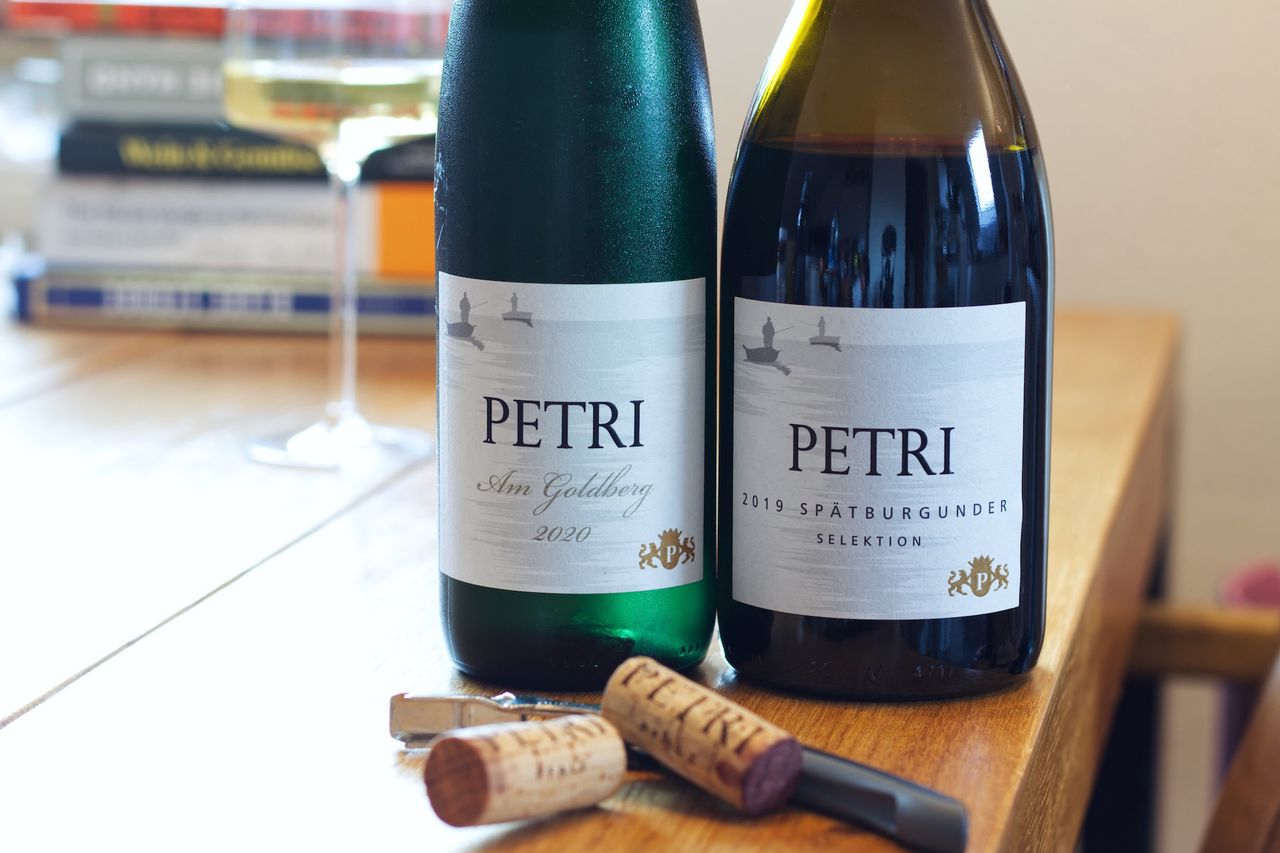Two Bottles Petri
We are drinking two bottles from the Petri winery in the Pfalz: a Spätburgunder Selektion 2019 and a Riesling Am Goldberg 2020.

The wines from Weingut Petri are a constant presence in our wine-drinking lives. Not that we would load up the trunk, we’re not the kind of customers for that, but they show up here and there year after year. It’s time they get their own feature here as well. They are also, as far as I can remember, the starting point of our Raffelt wine socialization. The episode of WRINT Flaschen back then ended up on our dinner table, albeit with some delay, cheers to asynchronous podcast listening, so it’s actually been a little less than ten years. But for almost ten years now, we’ve basically tasted every package, while Holgi asks questions and Christoph explains. It’s a bit crazy that it’s been so long. Back then, the wine package cost 31.90 euros. That does make you a little nostalgic. At the same time, Petri might be the only winery where I can demonstrably say I’ve influenced others successfully, long before I ever wrote about what I was drinking. And with my better halfs family, the trunk space is regularly well used.
Maximilian and Philipp Petri, the current generation, make wine in Herxheim am Berg in the Pfalz, where the Petri family can build on the work of 14 previous generations. The “am Berg” part matters, because just a bit further south there’s another Herxheim, near Landau, and if you’re traveling from far enough away and only glance at the general direction on your GPS, it looks eerily plausible. How do I know? Well. Herxheim am Berg is north of Bad Dürkheim, just after Kallstadt. And even with a brief GPS misdirection, distances in the Pfalz are short and the way is quickly found. Making your way through the assortment, however, quickly becomes a mammoth task even when visiting the winery, the wine list was already crazily extensive ten years ago and it still is today. From this range, we’re drinking a bottle of Riesling Am Golberg 2020 and a bottle of Spätburgunder Selektion 2019 from the Herxheimer Honigsack, matured in small oak barrels.
When I picture Riesling, this Goldberg is exactly what that smells like in my mind: yellow stone fruit, a touch of minerality, some flint. Just so typically Riesling. It’s crystal clear, and if you inhale deeply, there’s something creamy at the back. 2020, that’s five years by now. But maturity, or even a hint of it? Not at all. The acidity structure is fantastic, it has drive, but it’ll let you keep your gums on your jawbone. There’s fruit and some white citrus pith. The flavor lingers on the tongue, and the longer I keep my nose in the glass, the more herbal the wine becomes, and the more I like it.
Day two is practically unchanged. I have to say, I’m impressed, especially since the current vintage is available for under 15 euros. Back then, it was probably even less. At a time when, with many wineries, that’s about the entry level for estate wines, if at all, I think it’s worth mentioning. If this second evening is any indication, then a few more years of aging should be no problem. The acidity while drinking is now a hint fruitier, pineapple, citrus, and the creaminess recedes to the back. With a few sips, it briefly reminds me of pastry cream, but only until the acidity kicks in again. The aroma is exactly as it was the day before. Wonderful wine.
The Spätburgunder is quite roasted at first. Some warmth, spices, maybe star anise, lots of vanilla, some red bell pepper, plums, and dark cherries. It’s a shame we cooked the plum compote a day after the bottle was already empty, that would’ve been a great match for comparison. The cherries are also present on the palate, juicy, clear, and again a bit toasty with a lovely acidity and very fine tannins. It tastes noticeably fresher and cooler than it smells.
The wine becomes even softer overnight and just had a bit of bad timing. Nobody could have known that the late September weekend we drink this would bring another real summer’s day. At least, we sat at 31 degrees in the orchard picking plums, and the living room roof got plenty of sun. It really feels more like a wine for the cold season, and 15 degrees cooler outdoors would definitely set a better stage. The nose still shows plenty of toasty notes and spices. Lots of dark fruit, a touch of warmth. The bit of tannin that remained on the first night has completely melted now and caresses the tongue rather than providing any resistance. It’s full, round, soft, berry-like, with pastry notes and sour cherry, with smoke and leather, and less vanilla than the night before. I rather like it even in this heat, but in three months, the sips would surely be bigger.